Landmark Group Strategic Business Research Project Proposal: Overview
VerifiedAdded on 2021/06/01
|44
|11910
|63
Project
AI Summary
This project proposal outlines a strategic business research project for the Landmark Group, a Dubai-based multinational conglomerate. The proposal details the organization's overview, its relationship to the author (employee), and the relevance of the chosen context, focusing on sustainable retailing within the fashion industry, particularly in the Middle East. The project's scope includes an evaluation of current literature, identification of consumer behavior, and analysis of marketing techniques. Key objectives involve assessing brand awareness, image, trust, and loyalty. The proposal also includes a literature review, project composition, risk identification, resource allocation, project plan with Gantt chart, and financial and marketing objectives with project evaluation techniques. The project aims to identify opportunities and challenges within the fashion retail sector, providing a detailed roadmap for the project's execution and success, addressing potential risks and limitations, and setting measurable goals for profitability, market growth, and brand recognition.
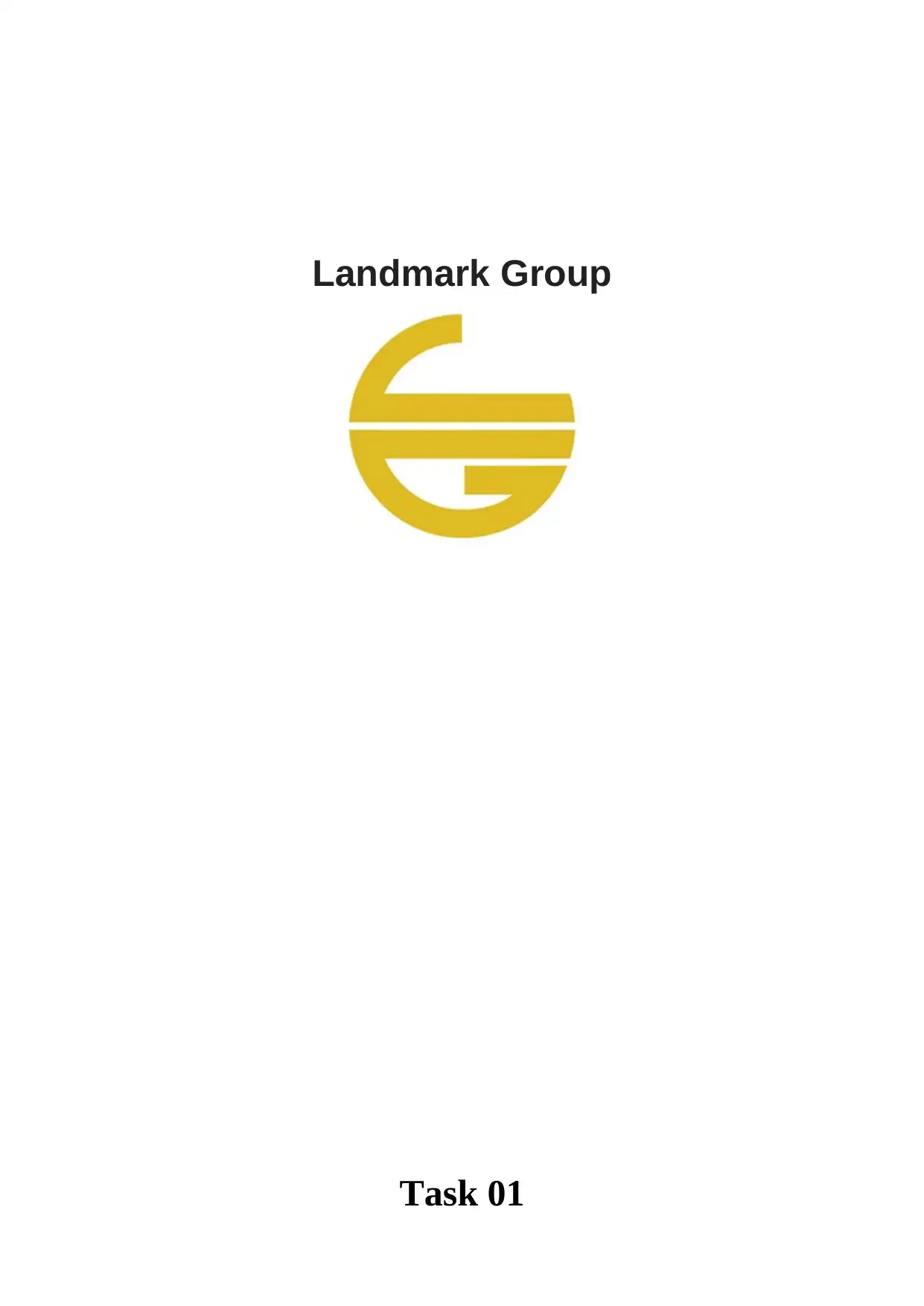
Landmark Group
Task 01
Task 01
Paraphrase This Document
Need a fresh take? Get an instant paraphrase of this document with our AI Paraphraser
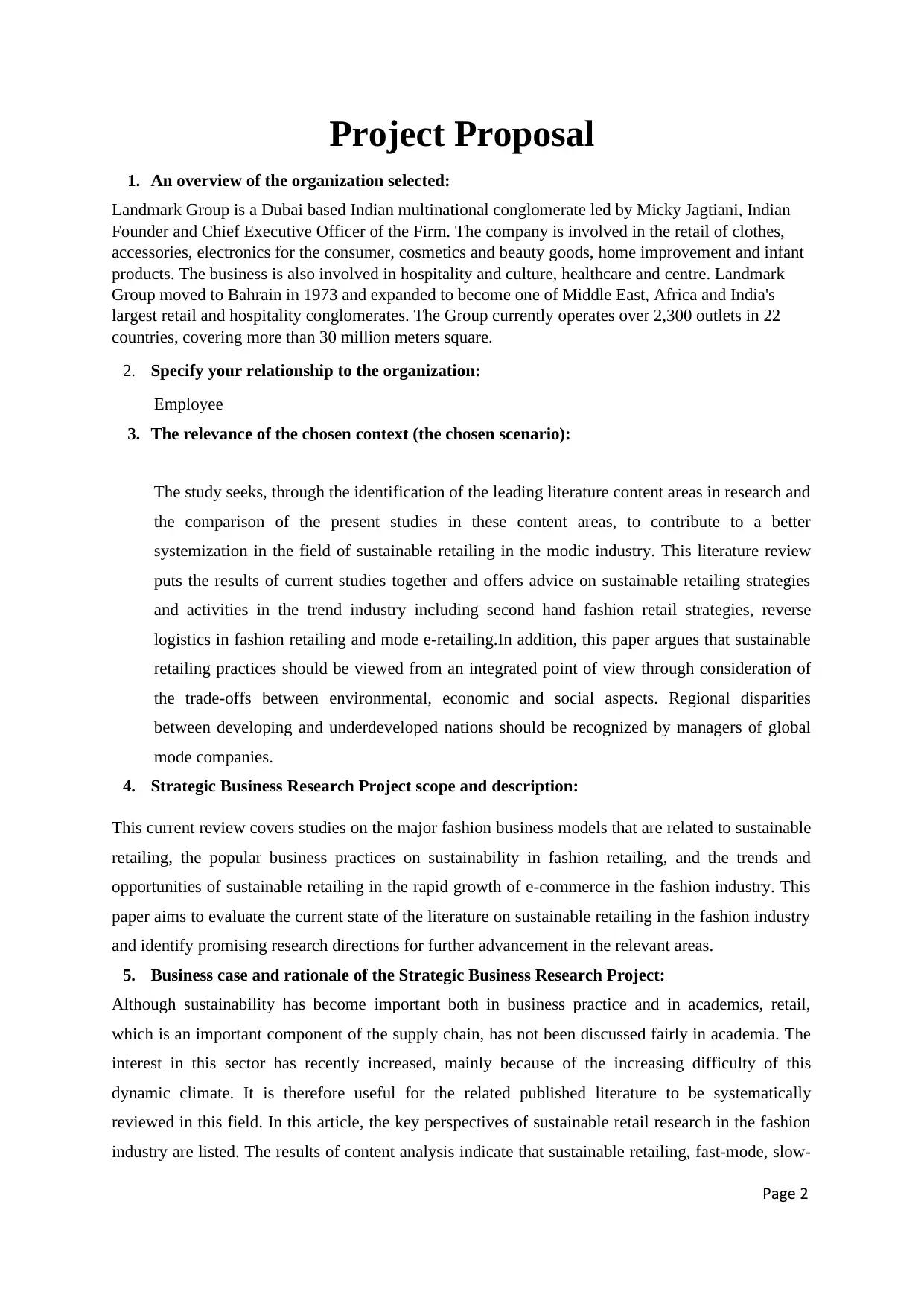
Project Proposal
1. An overview of the organization selected:
Landmark Group is a Dubai based Indian multinational conglomerate led by Micky Jagtiani, Indian
Founder and Chief Executive Officer of the Firm. The company is involved in the retail of clothes,
accessories, electronics for the consumer, cosmetics and beauty goods, home improvement and infant
products. The business is also involved in hospitality and culture, healthcare and centre. Landmark
Group moved to Bahrain in 1973 and expanded to become one of Middle East, Africa and India's
largest retail and hospitality conglomerates. The Group currently operates over 2,300 outlets in 22
countries, covering more than 30 million meters square.
2. Specify your relationship to the organization:
Employee
3. The relevance of the chosen context (the chosen scenario):
The study seeks, through the identification of the leading literature content areas in research and
the comparison of the present studies in these content areas, to contribute to a better
systemization in the field of sustainable retailing in the modic industry. This literature review
puts the results of current studies together and offers advice on sustainable retailing strategies
and activities in the trend industry including second hand fashion retail strategies, reverse
logistics in fashion retailing and mode e-retailing.In addition, this paper argues that sustainable
retailing practices should be viewed from an integrated point of view through consideration of
the trade-offs between environmental, economic and social aspects. Regional disparities
between developing and underdeveloped nations should be recognized by managers of global
mode companies.
4. Strategic Business Research Project scope and description:
This current review covers studies on the major fashion business models that are related to sustainable
retailing, the popular business practices on sustainability in fashion retailing, and the trends and
opportunities of sustainable retailing in the rapid growth of e-commerce in the fashion industry. This
paper aims to evaluate the current state of the literature on sustainable retailing in the fashion industry
and identify promising research directions for further advancement in the relevant areas.
5. Business case and rationale of the Strategic Business Research Project:
Although sustainability has become important both in business practice and in academics, retail,
which is an important component of the supply chain, has not been discussed fairly in academia. The
interest in this sector has recently increased, mainly because of the increasing difficulty of this
dynamic climate. It is therefore useful for the related published literature to be systematically
reviewed in this field. In this article, the key perspectives of sustainable retail research in the fashion
industry are listed. The results of content analysis indicate that sustainable retailing, fast-mode, slow-
Page 2
1. An overview of the organization selected:
Landmark Group is a Dubai based Indian multinational conglomerate led by Micky Jagtiani, Indian
Founder and Chief Executive Officer of the Firm. The company is involved in the retail of clothes,
accessories, electronics for the consumer, cosmetics and beauty goods, home improvement and infant
products. The business is also involved in hospitality and culture, healthcare and centre. Landmark
Group moved to Bahrain in 1973 and expanded to become one of Middle East, Africa and India's
largest retail and hospitality conglomerates. The Group currently operates over 2,300 outlets in 22
countries, covering more than 30 million meters square.
2. Specify your relationship to the organization:
Employee
3. The relevance of the chosen context (the chosen scenario):
The study seeks, through the identification of the leading literature content areas in research and
the comparison of the present studies in these content areas, to contribute to a better
systemization in the field of sustainable retailing in the modic industry. This literature review
puts the results of current studies together and offers advice on sustainable retailing strategies
and activities in the trend industry including second hand fashion retail strategies, reverse
logistics in fashion retailing and mode e-retailing.In addition, this paper argues that sustainable
retailing practices should be viewed from an integrated point of view through consideration of
the trade-offs between environmental, economic and social aspects. Regional disparities
between developing and underdeveloped nations should be recognized by managers of global
mode companies.
4. Strategic Business Research Project scope and description:
This current review covers studies on the major fashion business models that are related to sustainable
retailing, the popular business practices on sustainability in fashion retailing, and the trends and
opportunities of sustainable retailing in the rapid growth of e-commerce in the fashion industry. This
paper aims to evaluate the current state of the literature on sustainable retailing in the fashion industry
and identify promising research directions for further advancement in the relevant areas.
5. Business case and rationale of the Strategic Business Research Project:
Although sustainability has become important both in business practice and in academics, retail,
which is an important component of the supply chain, has not been discussed fairly in academia. The
interest in this sector has recently increased, mainly because of the increasing difficulty of this
dynamic climate. It is therefore useful for the related published literature to be systematically
reviewed in this field. In this article, the key perspectives of sustainable retail research in the fashion
industry are listed. The results of content analysis indicate that sustainable retailing, fast-mode, slow-
Page 2
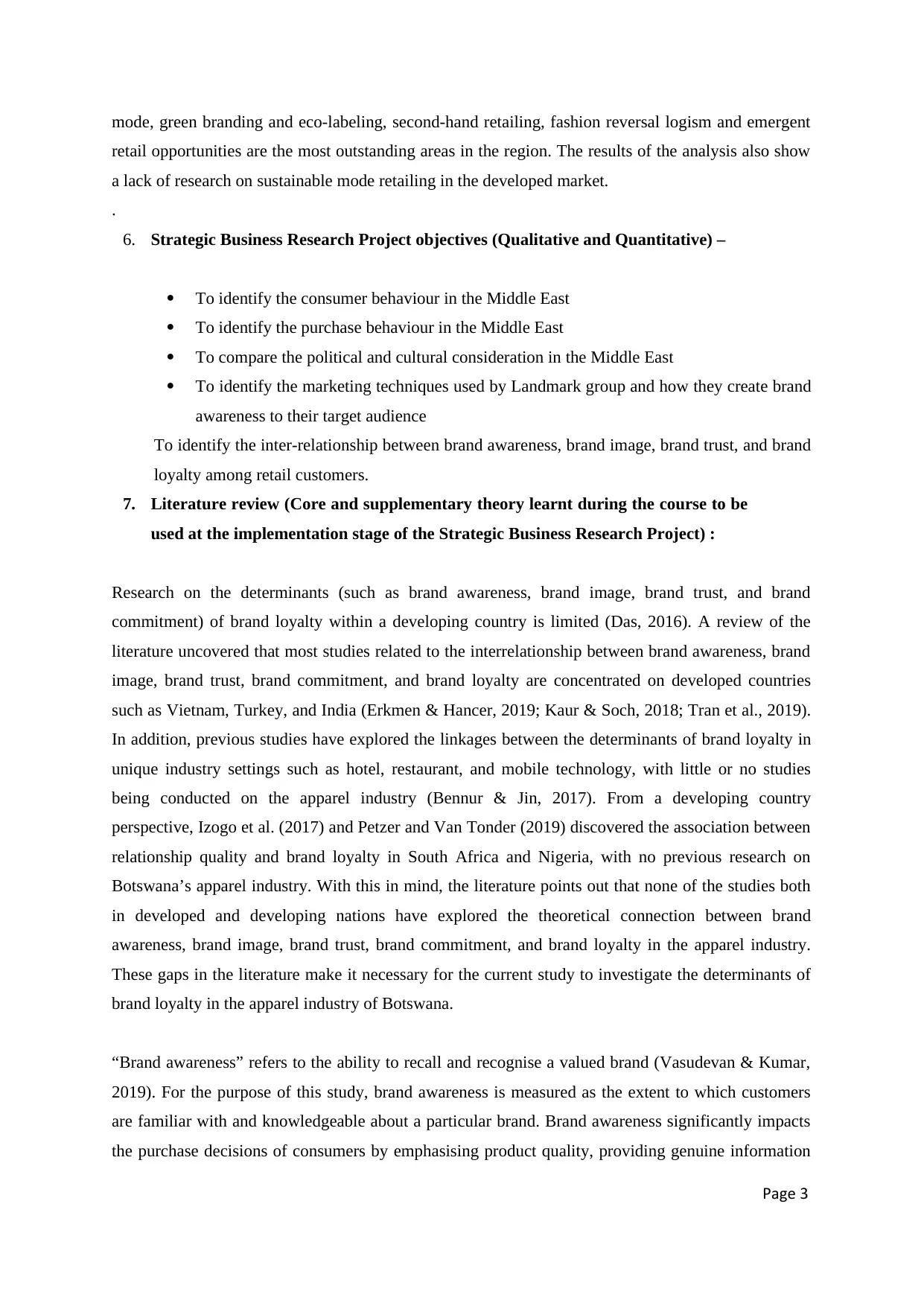
mode, green branding and eco-labeling, second-hand retailing, fashion reversal logism and emergent
retail opportunities are the most outstanding areas in the region. The results of the analysis also show
a lack of research on sustainable mode retailing in the developed market.
.
6. Strategic Business Research Project objectives (Qualitative and Quantitative) –
To identify the consumer behaviour in the Middle East
To identify the purchase behaviour in the Middle East
To compare the political and cultural consideration in the Middle East
To identify the marketing techniques used by Landmark group and how they create brand
awareness to their target audience
To identify the inter-relationship between brand awareness, brand image, brand trust, and brand
loyalty among retail customers.
7. Literature review (Core and supplementary theory learnt during the course to be
used at the implementation stage of the Strategic Business Research Project) :
Research on the determinants (such as brand awareness, brand image, brand trust, and brand
commitment) of brand loyalty within a developing country is limited (Das, 2016). A review of the
literature uncovered that most studies related to the interrelationship between brand awareness, brand
image, brand trust, brand commitment, and brand loyalty are concentrated on developed countries
such as Vietnam, Turkey, and India (Erkmen & Hancer, 2019; Kaur & Soch, 2018; Tran et al., 2019).
In addition, previous studies have explored the linkages between the determinants of brand loyalty in
unique industry settings such as hotel, restaurant, and mobile technology, with little or no studies
being conducted on the apparel industry (Bennur & Jin, 2017). From a developing country
perspective, Izogo et al. (2017) and Petzer and Van Tonder (2019) discovered the association between
relationship quality and brand loyalty in South Africa and Nigeria, with no previous research on
Botswana’s apparel industry. With this in mind, the literature points out that none of the studies both
in developed and developing nations have explored the theoretical connection between brand
awareness, brand image, brand trust, brand commitment, and brand loyalty in the apparel industry.
These gaps in the literature make it necessary for the current study to investigate the determinants of
brand loyalty in the apparel industry of Botswana.
“Brand awareness” refers to the ability to recall and recognise a valued brand (Vasudevan & Kumar,
2019). For the purpose of this study, brand awareness is measured as the extent to which customers
are familiar with and knowledgeable about a particular brand. Brand awareness significantly impacts
the purchase decisions of consumers by emphasising product quality, providing genuine information
Page 3
retail opportunities are the most outstanding areas in the region. The results of the analysis also show
a lack of research on sustainable mode retailing in the developed market.
.
6. Strategic Business Research Project objectives (Qualitative and Quantitative) –
To identify the consumer behaviour in the Middle East
To identify the purchase behaviour in the Middle East
To compare the political and cultural consideration in the Middle East
To identify the marketing techniques used by Landmark group and how they create brand
awareness to their target audience
To identify the inter-relationship between brand awareness, brand image, brand trust, and brand
loyalty among retail customers.
7. Literature review (Core and supplementary theory learnt during the course to be
used at the implementation stage of the Strategic Business Research Project) :
Research on the determinants (such as brand awareness, brand image, brand trust, and brand
commitment) of brand loyalty within a developing country is limited (Das, 2016). A review of the
literature uncovered that most studies related to the interrelationship between brand awareness, brand
image, brand trust, brand commitment, and brand loyalty are concentrated on developed countries
such as Vietnam, Turkey, and India (Erkmen & Hancer, 2019; Kaur & Soch, 2018; Tran et al., 2019).
In addition, previous studies have explored the linkages between the determinants of brand loyalty in
unique industry settings such as hotel, restaurant, and mobile technology, with little or no studies
being conducted on the apparel industry (Bennur & Jin, 2017). From a developing country
perspective, Izogo et al. (2017) and Petzer and Van Tonder (2019) discovered the association between
relationship quality and brand loyalty in South Africa and Nigeria, with no previous research on
Botswana’s apparel industry. With this in mind, the literature points out that none of the studies both
in developed and developing nations have explored the theoretical connection between brand
awareness, brand image, brand trust, brand commitment, and brand loyalty in the apparel industry.
These gaps in the literature make it necessary for the current study to investigate the determinants of
brand loyalty in the apparel industry of Botswana.
“Brand awareness” refers to the ability to recall and recognise a valued brand (Vasudevan & Kumar,
2019). For the purpose of this study, brand awareness is measured as the extent to which customers
are familiar with and knowledgeable about a particular brand. Brand awareness significantly impacts
the purchase decisions of consumers by emphasising product quality, providing genuine information
Page 3
⊘ This is a preview!⊘
Do you want full access?
Subscribe today to unlock all pages.

Trusted by 1+ million students worldwide
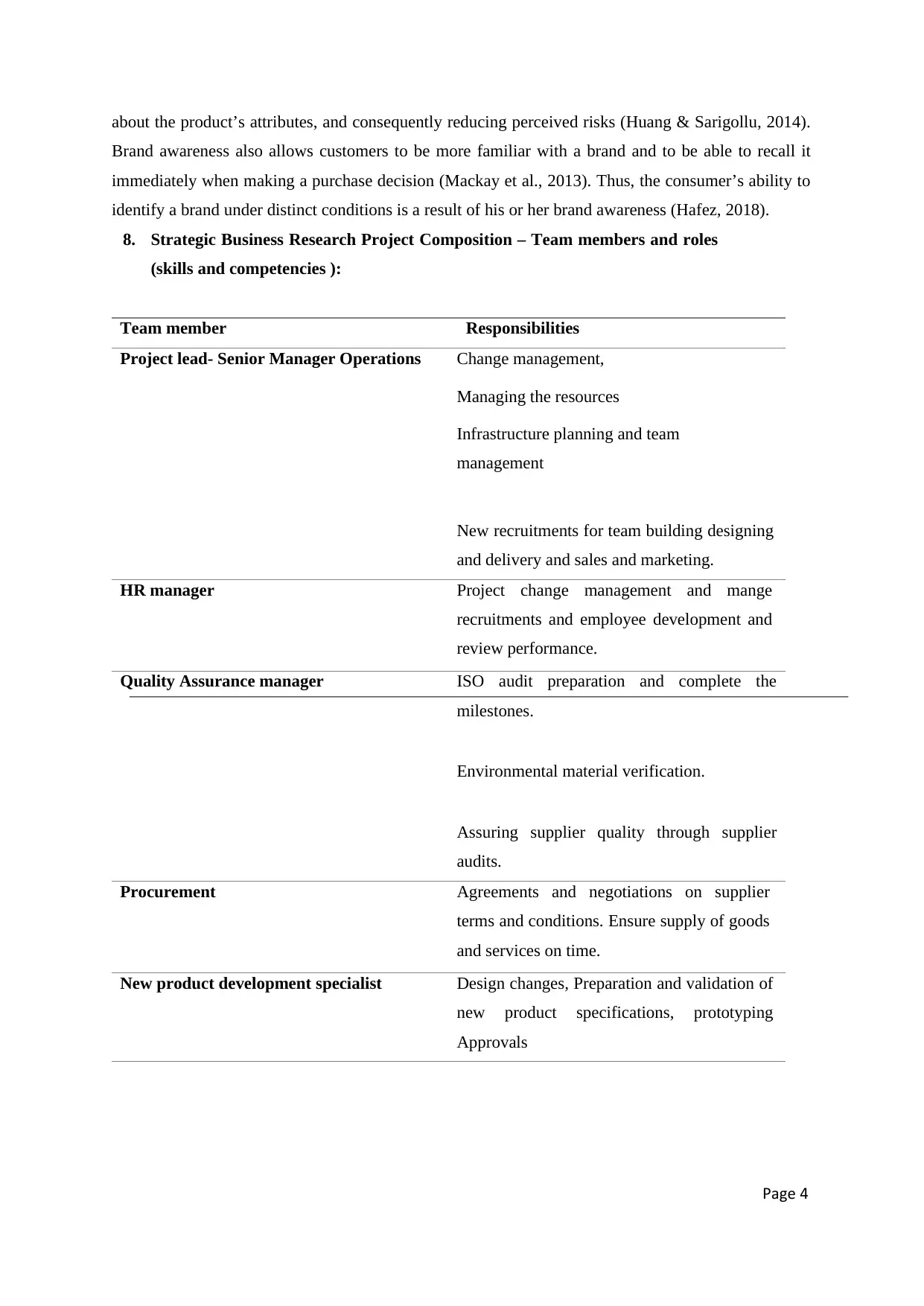
about the product’s attributes, and consequently reducing perceived risks (Huang & Sarigollu, 2014).
Brand awareness also allows customers to be more familiar with a brand and to be able to recall it
immediately when making a purchase decision (Mackay et al., 2013). Thus, the consumer’s ability to
identify a brand under distinct conditions is a result of his or her brand awareness (Hafez, 2018).
8. Strategic Business Research Project Composition – Team members and roles
(skills and competencies ):
Team member Responsibilities
Project lead- Senior Manager Operations Change management,
Managing the resources
Infrastructure planning and team
management
New recruitments for team building designing
and delivery and sales and marketing.
HR manager Project change management and mange
recruitments and employee development and
review performance.
Quality Assurance manager ISO audit preparation and complete the
milestones.
Environmental material verification.
Assuring supplier quality through supplier
audits.
Procurement Agreements and negotiations on supplier
terms and conditions. Ensure supply of goods
and services on time.
New product development specialist Design changes, Preparation and validation of
new product specifications, prototyping
Approvals
Page 4
Brand awareness also allows customers to be more familiar with a brand and to be able to recall it
immediately when making a purchase decision (Mackay et al., 2013). Thus, the consumer’s ability to
identify a brand under distinct conditions is a result of his or her brand awareness (Hafez, 2018).
8. Strategic Business Research Project Composition – Team members and roles
(skills and competencies ):
Team member Responsibilities
Project lead- Senior Manager Operations Change management,
Managing the resources
Infrastructure planning and team
management
New recruitments for team building designing
and delivery and sales and marketing.
HR manager Project change management and mange
recruitments and employee development and
review performance.
Quality Assurance manager ISO audit preparation and complete the
milestones.
Environmental material verification.
Assuring supplier quality through supplier
audits.
Procurement Agreements and negotiations on supplier
terms and conditions. Ensure supply of goods
and services on time.
New product development specialist Design changes, Preparation and validation of
new product specifications, prototyping
Approvals
Page 4
Paraphrase This Document
Need a fresh take? Get an instant paraphrase of this document with our AI Paraphraser
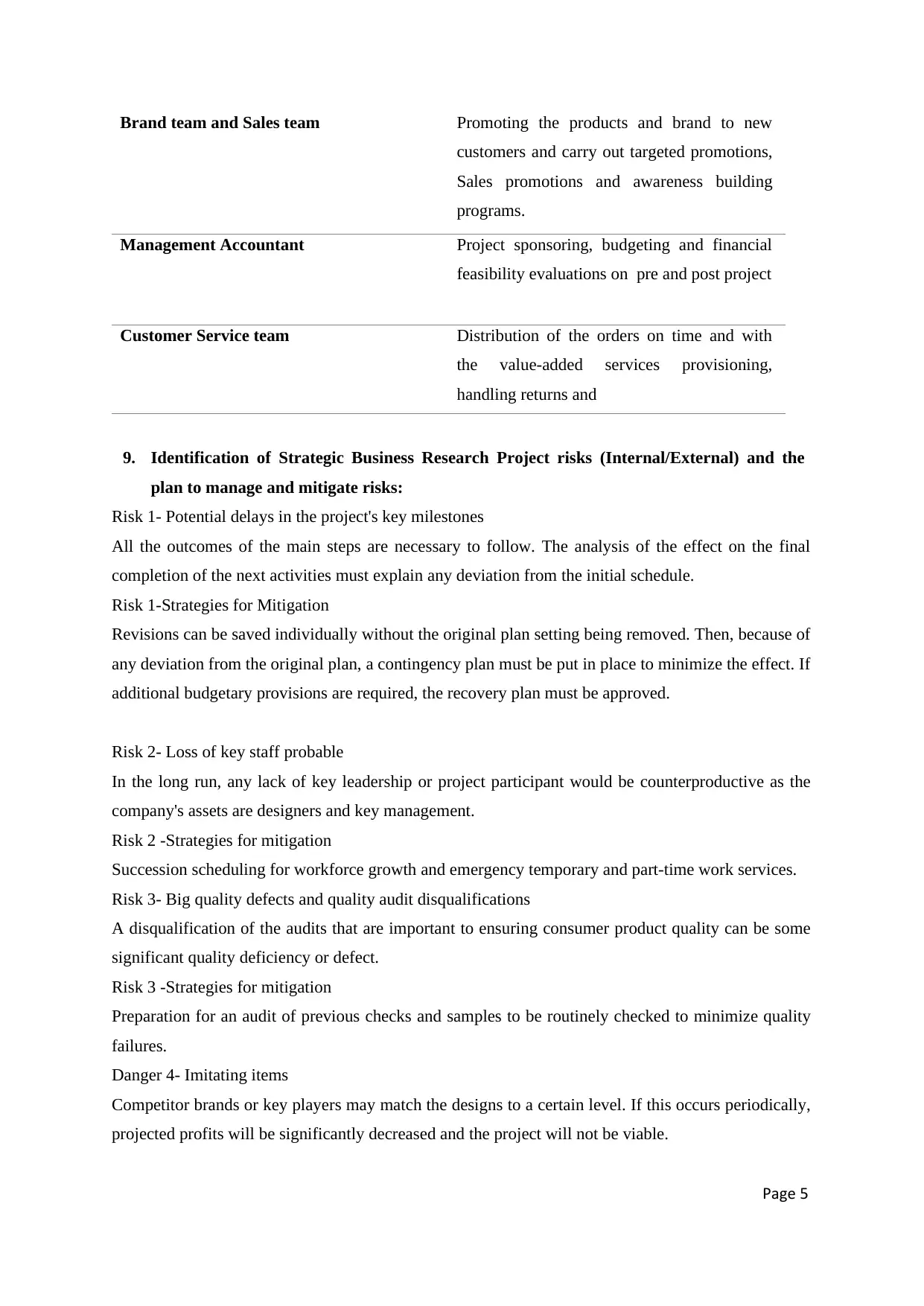
Brand team and Sales team Promoting the products and brand to new
customers and carry out targeted promotions,
Sales promotions and awareness building
programs.
Management Accountant Project sponsoring, budgeting and financial
feasibility evaluations on pre and post project
Customer Service team Distribution of the orders on time and with
the value-added services provisioning,
handling returns and
9. Identification of Strategic Business Research Project risks (Internal/External) and the
plan to manage and mitigate risks:
Risk 1- Potential delays in the project's key milestones
All the outcomes of the main steps are necessary to follow. The analysis of the effect on the final
completion of the next activities must explain any deviation from the initial schedule.
Risk 1-Strategies for Mitigation
Revisions can be saved individually without the original plan setting being removed. Then, because of
any deviation from the original plan, a contingency plan must be put in place to minimize the effect. If
additional budgetary provisions are required, the recovery plan must be approved.
Risk 2- Loss of key staff probable
In the long run, any lack of key leadership or project participant would be counterproductive as the
company's assets are designers and key management.
Risk 2 -Strategies for mitigation
Succession scheduling for workforce growth and emergency temporary and part-time work services.
Risk 3- Big quality defects and quality audit disqualifications
A disqualification of the audits that are important to ensuring consumer product quality can be some
significant quality deficiency or defect.
Risk 3 -Strategies for mitigation
Preparation for an audit of previous checks and samples to be routinely checked to minimize quality
failures.
Danger 4- Imitating items
Competitor brands or key players may match the designs to a certain level. If this occurs periodically,
projected profits will be significantly decreased and the project will not be viable.
Page 5
customers and carry out targeted promotions,
Sales promotions and awareness building
programs.
Management Accountant Project sponsoring, budgeting and financial
feasibility evaluations on pre and post project
Customer Service team Distribution of the orders on time and with
the value-added services provisioning,
handling returns and
9. Identification of Strategic Business Research Project risks (Internal/External) and the
plan to manage and mitigate risks:
Risk 1- Potential delays in the project's key milestones
All the outcomes of the main steps are necessary to follow. The analysis of the effect on the final
completion of the next activities must explain any deviation from the initial schedule.
Risk 1-Strategies for Mitigation
Revisions can be saved individually without the original plan setting being removed. Then, because of
any deviation from the original plan, a contingency plan must be put in place to minimize the effect. If
additional budgetary provisions are required, the recovery plan must be approved.
Risk 2- Loss of key staff probable
In the long run, any lack of key leadership or project participant would be counterproductive as the
company's assets are designers and key management.
Risk 2 -Strategies for mitigation
Succession scheduling for workforce growth and emergency temporary and part-time work services.
Risk 3- Big quality defects and quality audit disqualifications
A disqualification of the audits that are important to ensuring consumer product quality can be some
significant quality deficiency or defect.
Risk 3 -Strategies for mitigation
Preparation for an audit of previous checks and samples to be routinely checked to minimize quality
failures.
Danger 4- Imitating items
Competitor brands or key players may match the designs to a certain level. If this occurs periodically,
projected profits will be significantly decreased and the project will not be viable.
Page 5
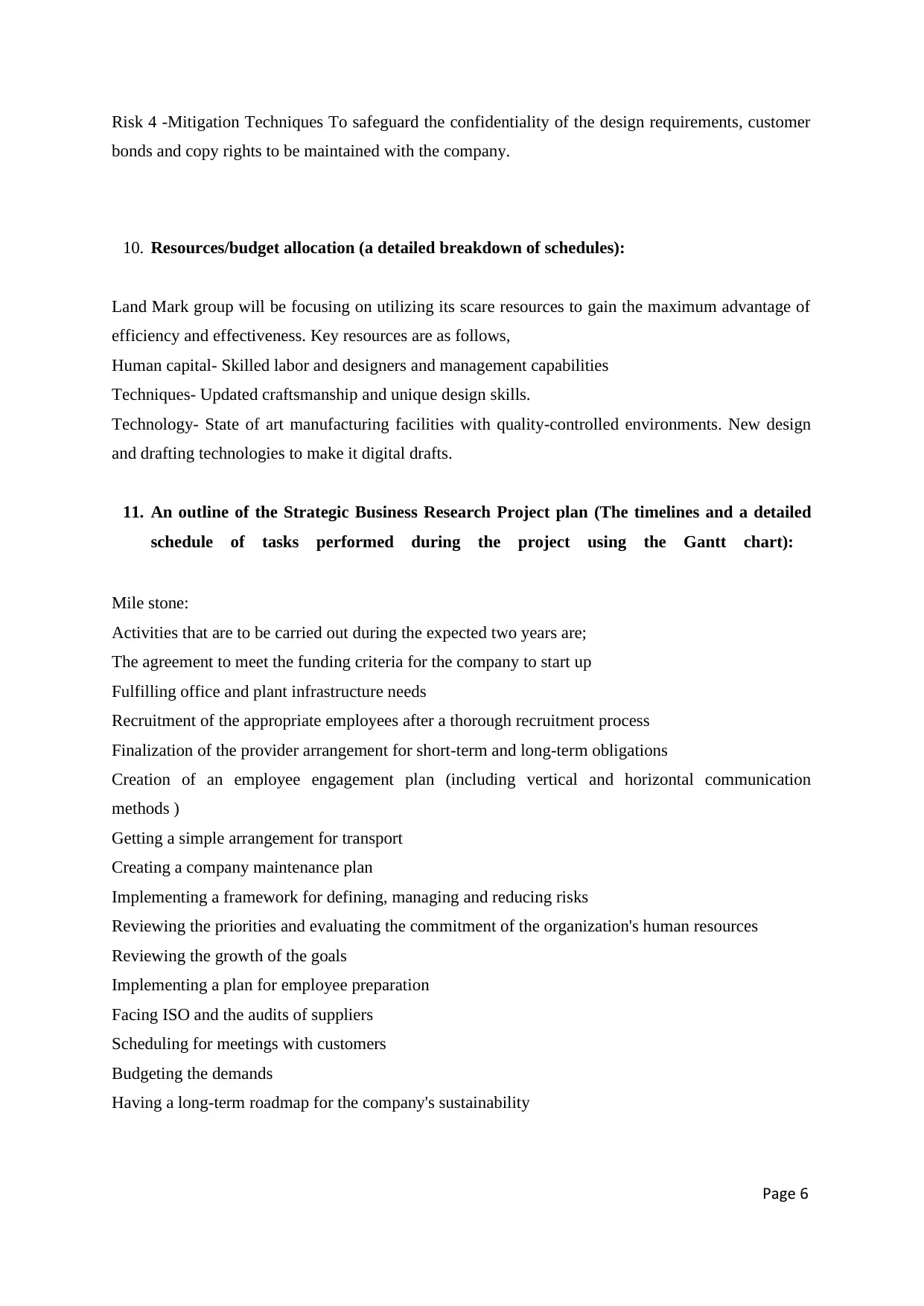
Risk 4 -Mitigation Techniques To safeguard the confidentiality of the design requirements, customer
bonds and copy rights to be maintained with the company.
10. Resources/budget allocation (a detailed breakdown of schedules):
Land Mark group will be focusing on utilizing its scare resources to gain the maximum advantage of
efficiency and effectiveness. Key resources are as follows,
Human capital- Skilled labor and designers and management capabilities
Techniques- Updated craftsmanship and unique design skills.
Technology- State of art manufacturing facilities with quality-controlled environments. New design
and drafting technologies to make it digital drafts.
11. An outline of the Strategic Business Research Project plan (The timelines and a detailed
schedule of tasks performed during the project using the Gantt chart):
Mile stone:
Activities that are to be carried out during the expected two years are;
The agreement to meet the funding criteria for the company to start up
Fulfilling office and plant infrastructure needs
Recruitment of the appropriate employees after a thorough recruitment process
Finalization of the provider arrangement for short-term and long-term obligations
Creation of an employee engagement plan (including vertical and horizontal communication
methods )
Getting a simple arrangement for transport
Creating a company maintenance plan
Implementing a framework for defining, managing and reducing risks
Reviewing the priorities and evaluating the commitment of the organization's human resources
Reviewing the growth of the goals
Implementing a plan for employee preparation
Facing ISO and the audits of suppliers
Scheduling for meetings with customers
Budgeting the demands
Having a long-term roadmap for the company's sustainability
Page 6
bonds and copy rights to be maintained with the company.
10. Resources/budget allocation (a detailed breakdown of schedules):
Land Mark group will be focusing on utilizing its scare resources to gain the maximum advantage of
efficiency and effectiveness. Key resources are as follows,
Human capital- Skilled labor and designers and management capabilities
Techniques- Updated craftsmanship and unique design skills.
Technology- State of art manufacturing facilities with quality-controlled environments. New design
and drafting technologies to make it digital drafts.
11. An outline of the Strategic Business Research Project plan (The timelines and a detailed
schedule of tasks performed during the project using the Gantt chart):
Mile stone:
Activities that are to be carried out during the expected two years are;
The agreement to meet the funding criteria for the company to start up
Fulfilling office and plant infrastructure needs
Recruitment of the appropriate employees after a thorough recruitment process
Finalization of the provider arrangement for short-term and long-term obligations
Creation of an employee engagement plan (including vertical and horizontal communication
methods )
Getting a simple arrangement for transport
Creating a company maintenance plan
Implementing a framework for defining, managing and reducing risks
Reviewing the priorities and evaluating the commitment of the organization's human resources
Reviewing the growth of the goals
Implementing a plan for employee preparation
Facing ISO and the audits of suppliers
Scheduling for meetings with customers
Budgeting the demands
Having a long-term roadmap for the company's sustainability
Page 6
⊘ This is a preview!⊘
Do you want full access?
Subscribe today to unlock all pages.

Trusted by 1+ million students worldwide
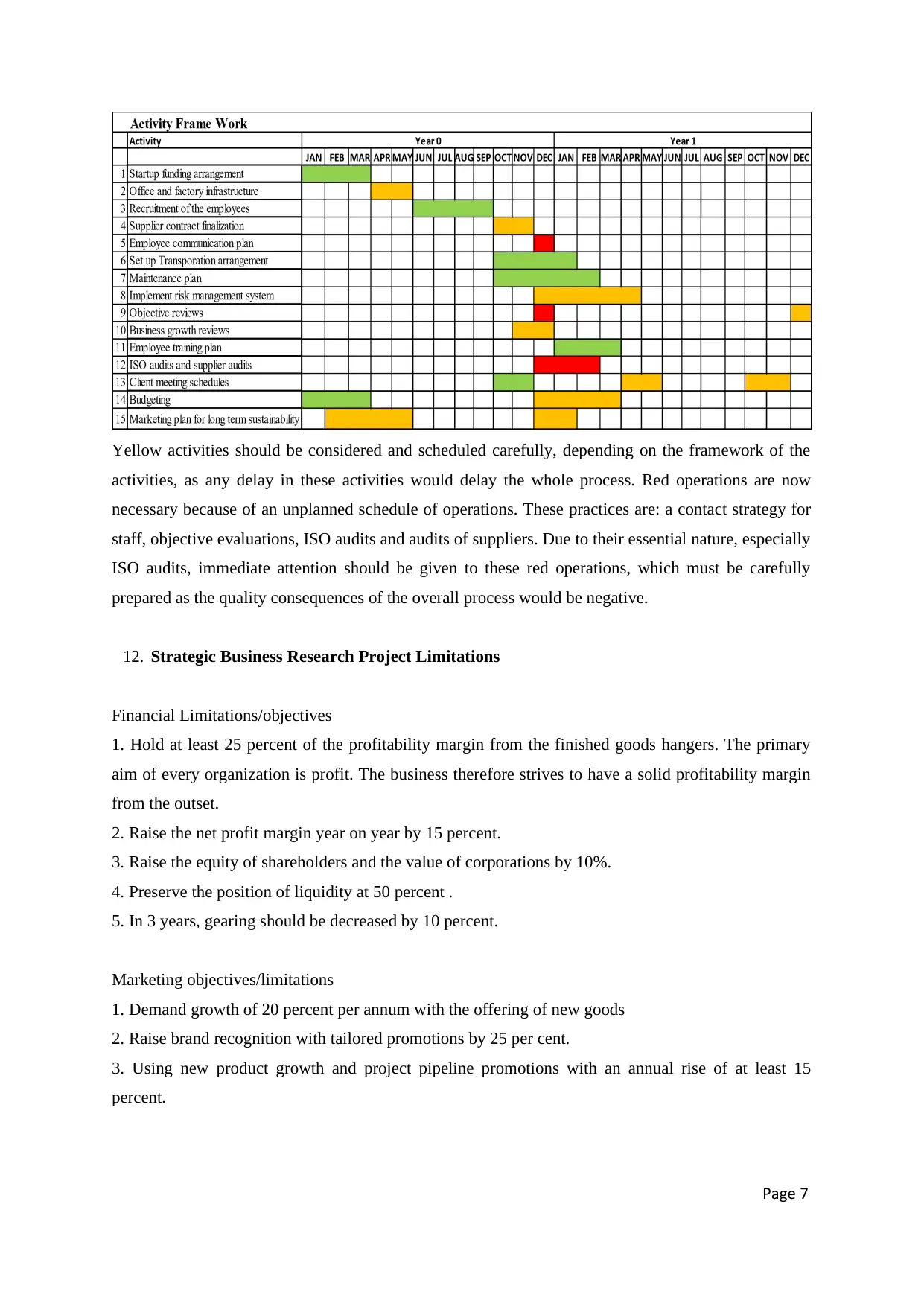
Yellow activities should be considered and scheduled carefully, depending on the framework of the
activities, as any delay in these activities would delay the whole process. Red operations are now
necessary because of an unplanned schedule of operations. These practices are: a contact strategy for
staff, objective evaluations, ISO audits and audits of suppliers. Due to their essential nature, especially
ISO audits, immediate attention should be given to these red operations, which must be carefully
prepared as the quality consequences of the overall process would be negative.
12. Strategic Business Research Project Limitations
Financial Limitations/objectives
1. Hold at least 25 percent of the profitability margin from the finished goods hangers. The primary
aim of every organization is profit. The business therefore strives to have a solid profitability margin
from the outset.
2. Raise the net profit margin year on year by 15 percent.
3. Raise the equity of shareholders and the value of corporations by 10%.
4. Preserve the position of liquidity at 50 percent .
5. In 3 years, gearing should be decreased by 10 percent.
Marketing objectives/limitations
1. Demand growth of 20 percent per annum with the offering of new goods
2. Raise brand recognition with tailored promotions by 25 per cent.
3. Using new product growth and project pipeline promotions with an annual rise of at least 15
percent.
Page 7
activities, as any delay in these activities would delay the whole process. Red operations are now
necessary because of an unplanned schedule of operations. These practices are: a contact strategy for
staff, objective evaluations, ISO audits and audits of suppliers. Due to their essential nature, especially
ISO audits, immediate attention should be given to these red operations, which must be carefully
prepared as the quality consequences of the overall process would be negative.
12. Strategic Business Research Project Limitations
Financial Limitations/objectives
1. Hold at least 25 percent of the profitability margin from the finished goods hangers. The primary
aim of every organization is profit. The business therefore strives to have a solid profitability margin
from the outset.
2. Raise the net profit margin year on year by 15 percent.
3. Raise the equity of shareholders and the value of corporations by 10%.
4. Preserve the position of liquidity at 50 percent .
5. In 3 years, gearing should be decreased by 10 percent.
Marketing objectives/limitations
1. Demand growth of 20 percent per annum with the offering of new goods
2. Raise brand recognition with tailored promotions by 25 per cent.
3. Using new product growth and project pipeline promotions with an annual rise of at least 15
percent.
Page 7
Paraphrase This Document
Need a fresh take? Get an instant paraphrase of this document with our AI Paraphraser
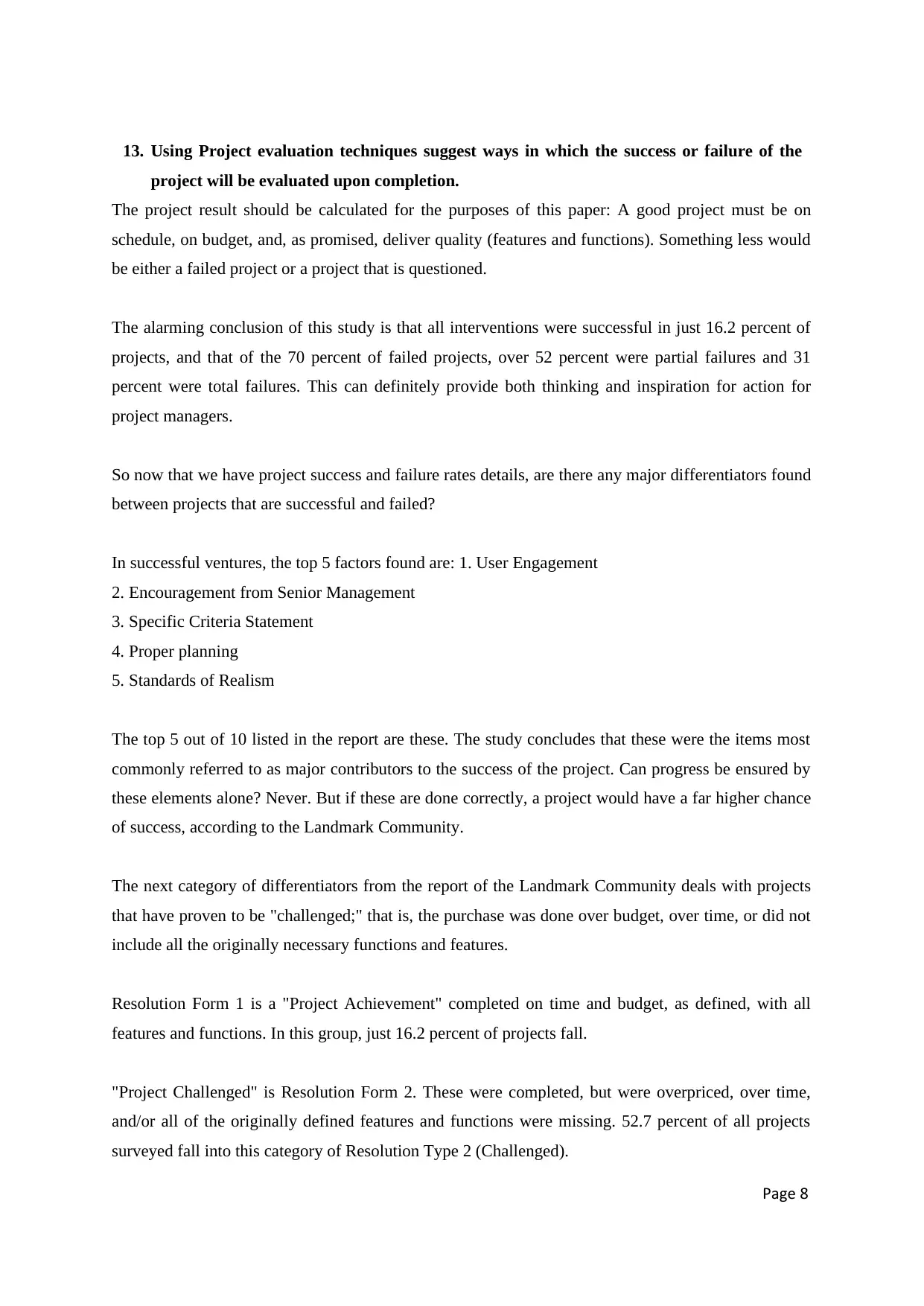
13. Using Project evaluation techniques suggest ways in which the success or failure of the
project will be evaluated upon completion.
The project result should be calculated for the purposes of this paper: A good project must be on
schedule, on budget, and, as promised, deliver quality (features and functions). Something less would
be either a failed project or a project that is questioned.
The alarming conclusion of this study is that all interventions were successful in just 16.2 percent of
projects, and that of the 70 percent of failed projects, over 52 percent were partial failures and 31
percent were total failures. This can definitely provide both thinking and inspiration for action for
project managers.
So now that we have project success and failure rates details, are there any major differentiators found
between projects that are successful and failed?
In successful ventures, the top 5 factors found are: 1. User Engagement
2. Encouragement from Senior Management
3. Specific Criteria Statement
4. Proper planning
5. Standards of Realism
The top 5 out of 10 listed in the report are these. The study concludes that these were the items most
commonly referred to as major contributors to the success of the project. Can progress be ensured by
these elements alone? Never. But if these are done correctly, a project would have a far higher chance
of success, according to the Landmark Community.
The next category of differentiators from the report of the Landmark Community deals with projects
that have proven to be "challenged;" that is, the purchase was done over budget, over time, or did not
include all the originally necessary functions and features.
Resolution Form 1 is a "Project Achievement" completed on time and budget, as defined, with all
features and functions. In this group, just 16.2 percent of projects fall.
"Project Challenged" is Resolution Form 2. These were completed, but were overpriced, over time,
and/or all of the originally defined features and functions were missing. 52.7 percent of all projects
surveyed fall into this category of Resolution Type 2 (Challenged).
Page 8
project will be evaluated upon completion.
The project result should be calculated for the purposes of this paper: A good project must be on
schedule, on budget, and, as promised, deliver quality (features and functions). Something less would
be either a failed project or a project that is questioned.
The alarming conclusion of this study is that all interventions were successful in just 16.2 percent of
projects, and that of the 70 percent of failed projects, over 52 percent were partial failures and 31
percent were total failures. This can definitely provide both thinking and inspiration for action for
project managers.
So now that we have project success and failure rates details, are there any major differentiators found
between projects that are successful and failed?
In successful ventures, the top 5 factors found are: 1. User Engagement
2. Encouragement from Senior Management
3. Specific Criteria Statement
4. Proper planning
5. Standards of Realism
The top 5 out of 10 listed in the report are these. The study concludes that these were the items most
commonly referred to as major contributors to the success of the project. Can progress be ensured by
these elements alone? Never. But if these are done correctly, a project would have a far higher chance
of success, according to the Landmark Community.
The next category of differentiators from the report of the Landmark Community deals with projects
that have proven to be "challenged;" that is, the purchase was done over budget, over time, or did not
include all the originally necessary functions and features.
Resolution Form 1 is a "Project Achievement" completed on time and budget, as defined, with all
features and functions. In this group, just 16.2 percent of projects fall.
"Project Challenged" is Resolution Form 2. These were completed, but were overpriced, over time,
and/or all of the originally defined features and functions were missing. 52.7 percent of all projects
surveyed fall into this category of Resolution Type 2 (Challenged).
Page 8
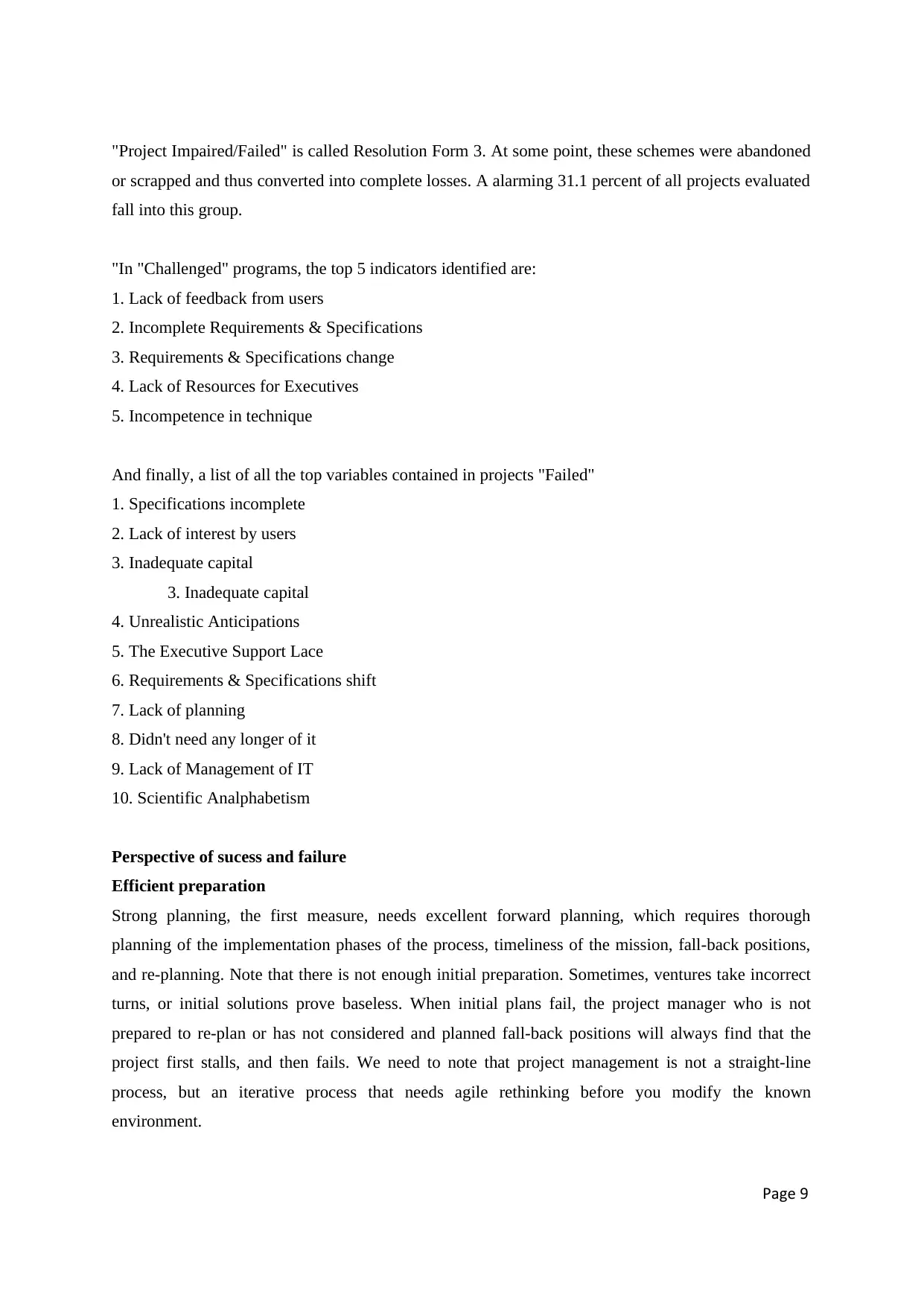
"Project Impaired/Failed" is called Resolution Form 3. At some point, these schemes were abandoned
or scrapped and thus converted into complete losses. A alarming 31.1 percent of all projects evaluated
fall into this group.
"In "Challenged" programs, the top 5 indicators identified are:
1. Lack of feedback from users
2. Incomplete Requirements & Specifications
3. Requirements & Specifications change
4. Lack of Resources for Executives
5. Incompetence in technique
And finally, a list of all the top variables contained in projects "Failed"
1. Specifications incomplete
2. Lack of interest by users
3. Inadequate capital
3. Inadequate capital
4. Unrealistic Anticipations
5. The Executive Support Lace
6. Requirements & Specifications shift
7. Lack of planning
8. Didn't need any longer of it
9. Lack of Management of IT
10. Scientific Analphabetism
Perspective of sucess and failure
Efficient preparation
Strong planning, the first measure, needs excellent forward planning, which requires thorough
planning of the implementation phases of the process, timeliness of the mission, fall-back positions,
and re-planning. Note that there is not enough initial preparation. Sometimes, ventures take incorrect
turns, or initial solutions prove baseless. When initial plans fail, the project manager who is not
prepared to re-plan or has not considered and planned fall-back positions will always find that the
project first stalls, and then fails. We need to note that project management is not a straight-line
process, but an iterative process that needs agile rethinking before you modify the known
environment.
Page 9
or scrapped and thus converted into complete losses. A alarming 31.1 percent of all projects evaluated
fall into this group.
"In "Challenged" programs, the top 5 indicators identified are:
1. Lack of feedback from users
2. Incomplete Requirements & Specifications
3. Requirements & Specifications change
4. Lack of Resources for Executives
5. Incompetence in technique
And finally, a list of all the top variables contained in projects "Failed"
1. Specifications incomplete
2. Lack of interest by users
3. Inadequate capital
3. Inadequate capital
4. Unrealistic Anticipations
5. The Executive Support Lace
6. Requirements & Specifications shift
7. Lack of planning
8. Didn't need any longer of it
9. Lack of Management of IT
10. Scientific Analphabetism
Perspective of sucess and failure
Efficient preparation
Strong planning, the first measure, needs excellent forward planning, which requires thorough
planning of the implementation phases of the process, timeliness of the mission, fall-back positions,
and re-planning. Note that there is not enough initial preparation. Sometimes, ventures take incorrect
turns, or initial solutions prove baseless. When initial plans fail, the project manager who is not
prepared to re-plan or has not considered and planned fall-back positions will always find that the
project first stalls, and then fails. We need to note that project management is not a straight-line
process, but an iterative process that needs agile rethinking before you modify the known
environment.
Page 9
⊘ This is a preview!⊘
Do you want full access?
Subscribe today to unlock all pages.

Trusted by 1+ million students worldwide
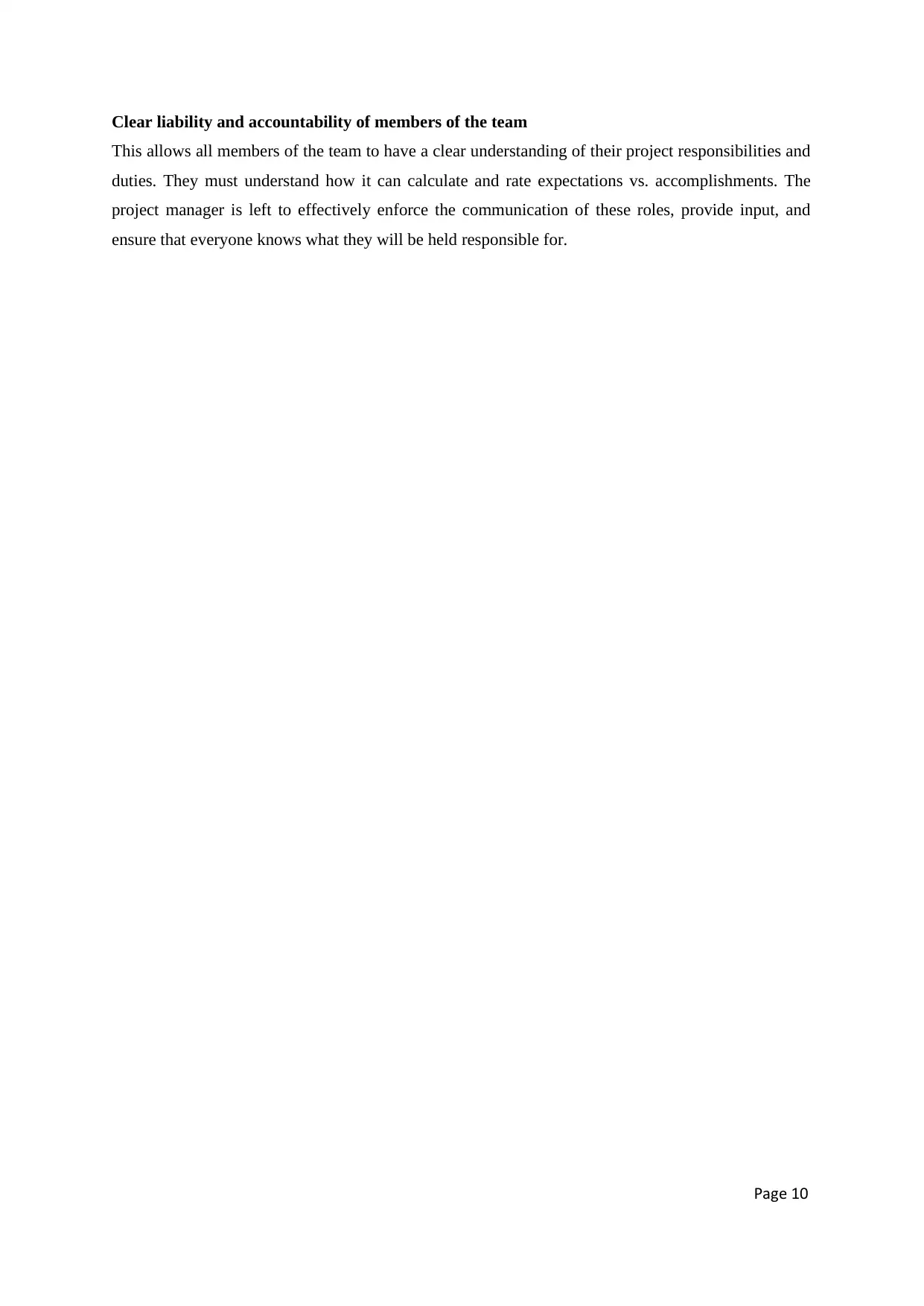
Clear liability and accountability of members of the team
This allows all members of the team to have a clear understanding of their project responsibilities and
duties. They must understand how it can calculate and rate expectations vs. accomplishments. The
project manager is left to effectively enforce the communication of these roles, provide input, and
ensure that everyone knows what they will be held responsible for.
Page 10
This allows all members of the team to have a clear understanding of their project responsibilities and
duties. They must understand how it can calculate and rate expectations vs. accomplishments. The
project manager is left to effectively enforce the communication of these roles, provide input, and
ensure that everyone knows what they will be held responsible for.
Page 10
Paraphrase This Document
Need a fresh take? Get an instant paraphrase of this document with our AI Paraphraser
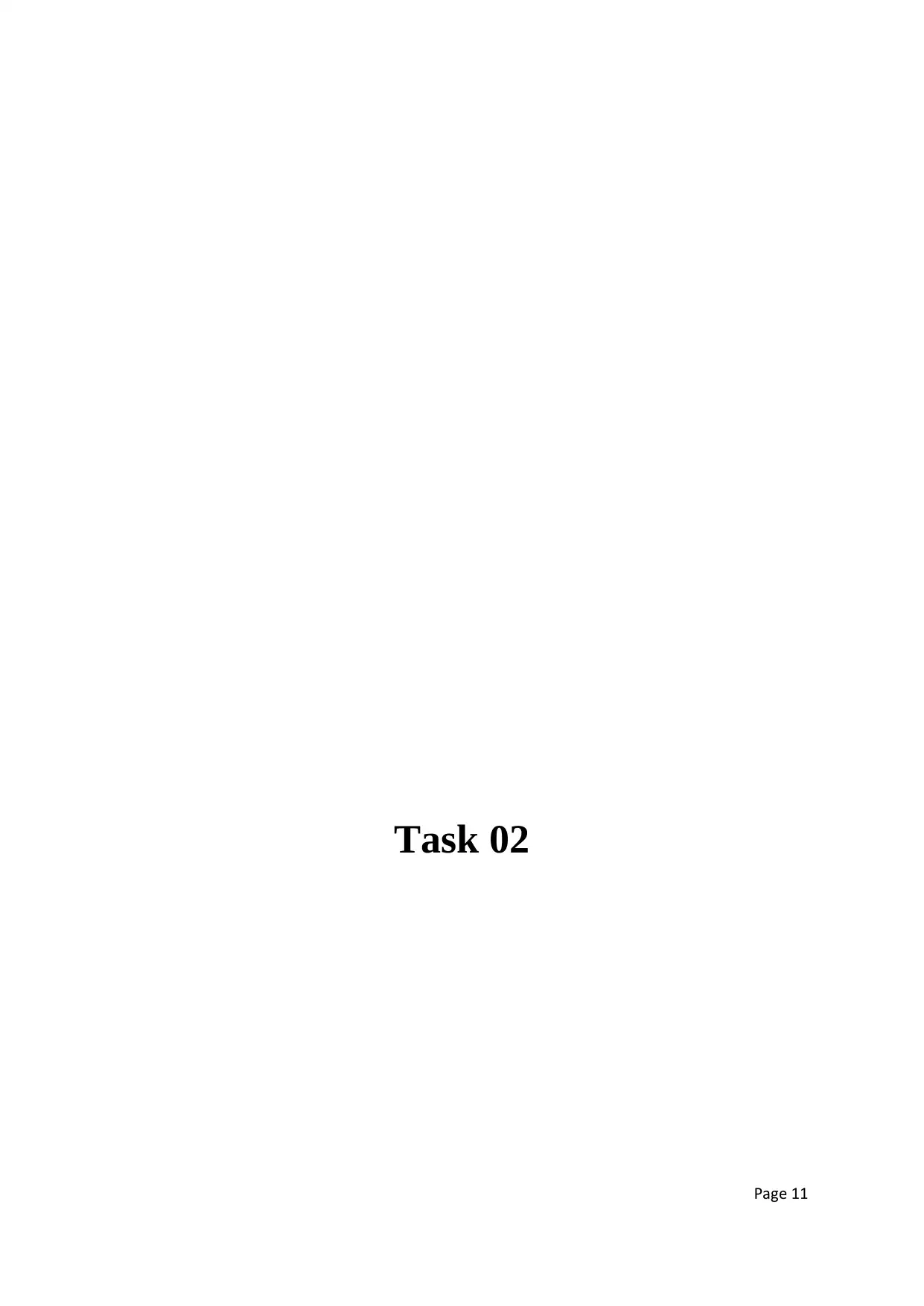
Task 02
Page 11
Page 11
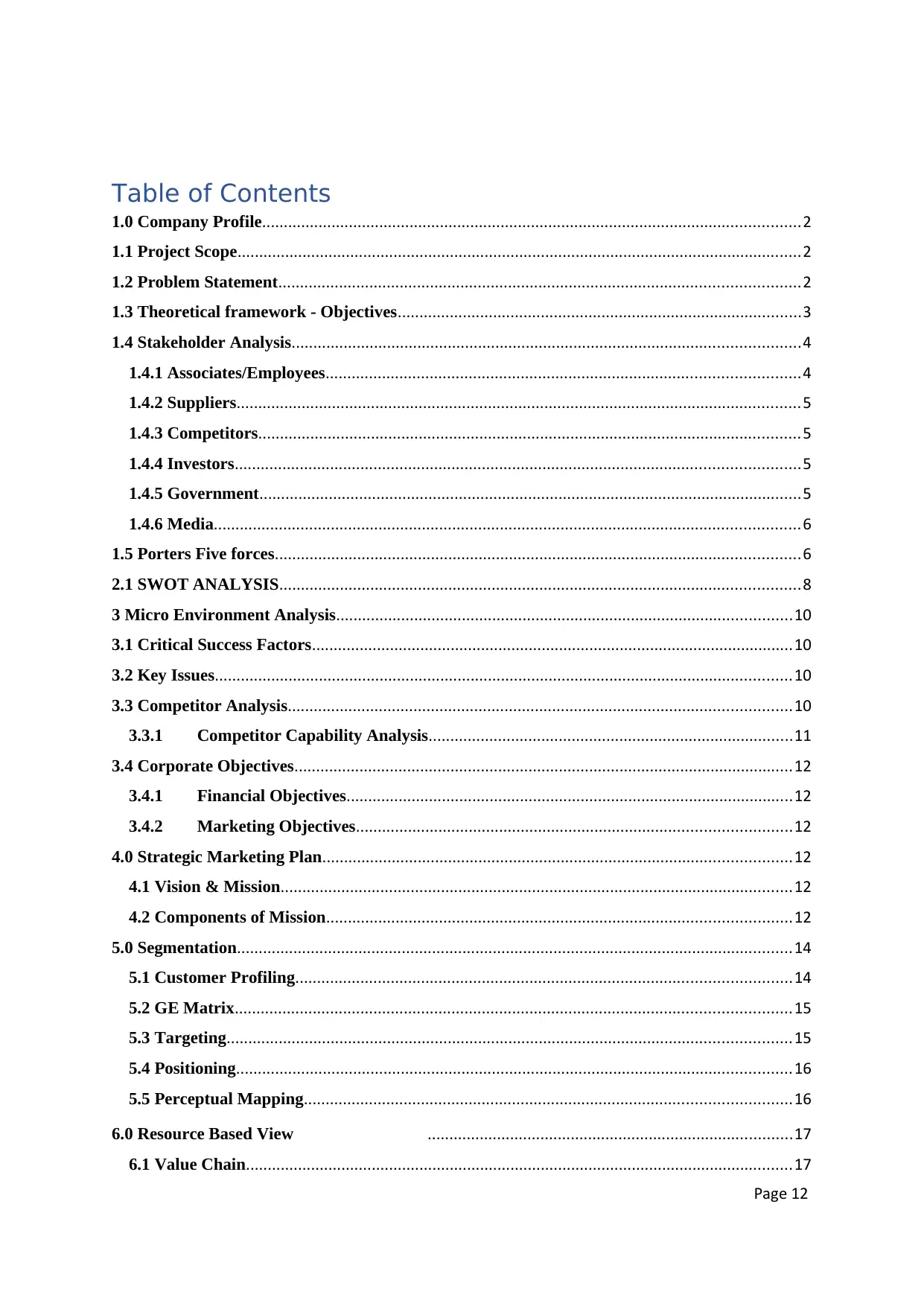
Table of Contents
1.0 Company Profile............................................................................................................................2
1.1 Project Scope..................................................................................................................................2
1.2 Problem Statement........................................................................................................................2
1.3 Theoretical framework - Objectives.............................................................................................3
1.4 Stakeholder Analysis.....................................................................................................................4
1.4.1 Associates/Employees.............................................................................................................4
1.4.2 Suppliers..................................................................................................................................5
1.4.3 Competitors.............................................................................................................................5
1.4.4 Investors..................................................................................................................................5
1.4.5 Government.............................................................................................................................5
1.4.6 Media.......................................................................................................................................6
1.5 Porters Five forces.........................................................................................................................6
2.1 SWOT ANALYSIS........................................................................................................................8
3 Micro Environment Analysis.........................................................................................................10
3.1 Critical Success Factors...............................................................................................................10
3.2 Key Issues.....................................................................................................................................10
3.3 Competitor Analysis....................................................................................................................10
3.3.1 Competitor Capability Analysis....................................................................................11
3.4 Corporate Objectives...................................................................................................................12
3.4.1 Financial Objectives.......................................................................................................12
3.4.2 Marketing Objectives....................................................................................................12
4.0 Strategic Marketing Plan............................................................................................................12
4.1 Vision & Mission......................................................................................................................12
4.2 Components of Mission...........................................................................................................12
5.0 Segmentation................................................................................................................................14
5.1 Customer Profiling..................................................................................................................14
5.2 GE Matrix................................................................................................................................15
5.3 Targeting..................................................................................................................................15
5.4 Positioning................................................................................................................................16
5.5 Perceptual Mapping................................................................................................................16
6.0 Resource Based View ....................................................................................17
6.1 Value Chain..............................................................................................................................17
Page 12
1.0 Company Profile............................................................................................................................2
1.1 Project Scope..................................................................................................................................2
1.2 Problem Statement........................................................................................................................2
1.3 Theoretical framework - Objectives.............................................................................................3
1.4 Stakeholder Analysis.....................................................................................................................4
1.4.1 Associates/Employees.............................................................................................................4
1.4.2 Suppliers..................................................................................................................................5
1.4.3 Competitors.............................................................................................................................5
1.4.4 Investors..................................................................................................................................5
1.4.5 Government.............................................................................................................................5
1.4.6 Media.......................................................................................................................................6
1.5 Porters Five forces.........................................................................................................................6
2.1 SWOT ANALYSIS........................................................................................................................8
3 Micro Environment Analysis.........................................................................................................10
3.1 Critical Success Factors...............................................................................................................10
3.2 Key Issues.....................................................................................................................................10
3.3 Competitor Analysis....................................................................................................................10
3.3.1 Competitor Capability Analysis....................................................................................11
3.4 Corporate Objectives...................................................................................................................12
3.4.1 Financial Objectives.......................................................................................................12
3.4.2 Marketing Objectives....................................................................................................12
4.0 Strategic Marketing Plan............................................................................................................12
4.1 Vision & Mission......................................................................................................................12
4.2 Components of Mission...........................................................................................................12
5.0 Segmentation................................................................................................................................14
5.1 Customer Profiling..................................................................................................................14
5.2 GE Matrix................................................................................................................................15
5.3 Targeting..................................................................................................................................15
5.4 Positioning................................................................................................................................16
5.5 Perceptual Mapping................................................................................................................16
6.0 Resource Based View ....................................................................................17
6.1 Value Chain..............................................................................................................................17
Page 12
⊘ This is a preview!⊘
Do you want full access?
Subscribe today to unlock all pages.

Trusted by 1+ million students worldwide
1 out of 44
Related Documents
Your All-in-One AI-Powered Toolkit for Academic Success.
+13062052269
info@desklib.com
Available 24*7 on WhatsApp / Email
![[object Object]](/_next/static/media/star-bottom.7253800d.svg)
Unlock your academic potential
Copyright © 2020–2025 A2Z Services. All Rights Reserved. Developed and managed by ZUCOL.





